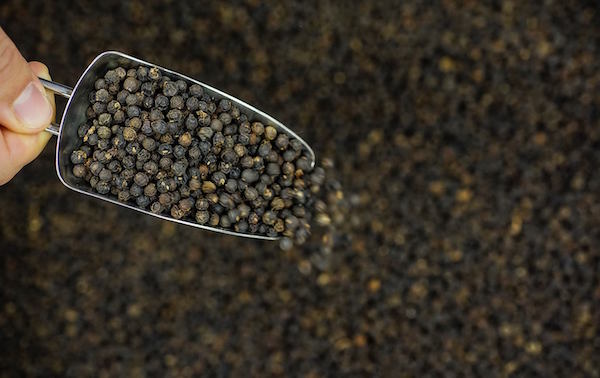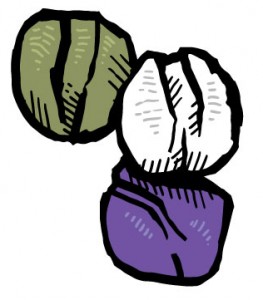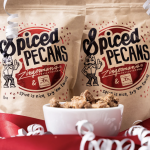Spice Week begins!
Zingerman’s is very pleased to welcome our friends, Canadian spice importers, the Spice Trekkers (aka Épices de Cru, en Français) to Ann Arbor this week for a series of special events centered around the use of whole spices in cooking.
We still have seats for tomorrow’s In Pursuit of Pepper dinner at Zingerman’s Roadhouse. Reserve your seat here.
Or click here for more information about the other public events at Zingerman’s Deli, and Zingerman’s BAKE!

Fresh peppercorns
A Dozen Different Peppercorns
BLACK PEPPER TELLICHERY RESERVE
Philippe de Vienne says, “Tellichery is probably the most famous and abused name in the black pepper trade. The town is one of many harbours on the south-western coast of India known as the Malabar Coast. The justly deserved reputation grew during the British period when the town was the export point for the area pepper. Over time the word Tellichery became synonymous with quality pepper. In those days the pepper from the surrounding mountains was exported through the now disused port of Thalassery as it is now called. The great peppers still come from the hills, most notably from the Wyanad area. Today other ports are used but the name remains, a sure sign of the reputation of the black pepper from this area. As the name does not benefit from an A.O.C. protection, it is greatly abused by people who want to project a quality image for their second rate pepper.”
The real thing is an inspiration. How do you know you have it? One obvious answer is buy from people you trust, as we do with the de Viennes. Another is to learn to know the smells and flavors that accompany the authentic article. The aroma of the de Vienne’s Telicherry Reserve is BIG. Stick your nose inside the tin and take a deep breath. Surprisingly, it doesn’t make me sneeze. It reminds of burnished old wood, of eucalyptus, of walking through the woods in northern California. The flavor is big too. Supermarket pepper by contrast, is rather one-dimensional, hot in a narrow and not all that enticing if still better than nothing kind of way. . It’s spicy but it’s hardly habanero-hot. This is a spice that livens the tongue, that continues to resonate without really ever taking over. The heat is rich, well-rounded, well off, worldly.
MLAMALA BLACK PEPPER FROM INDIA
The Mlamala pepper comes from the Cardamom Hills, near where the great green cardamom we get from the de Viennes (try it in the Armenian coffee at Zingerman’s Coffee Company) is coming from. It’s harvested in the hills facing the areas near the Periyar river where the de Viennes semi-wild Tribal black pepper (also amazing) come from. “Unlike tribal it is from a domesticated variety of pepper vines; hence the larger berries. Similar terroir, different varietal,” Philippe explained.
Part of the quality comes from the altitude—these Mlamala pepper vines grow at 2500 to 3000 feet above sea level. The area gets a lot of sunlight which, along with the good local soil, naturally fertilized by the farmers, yields large and full flavored berries. Careful and timely harvesting and processing complete the picture. It’s a delicious, full flavored, spicy regional black pepper. Use it any way you would use other black peppercorns, which, if you’re like me, means on almost everything. Salads, pastas, meats, seafood, soup, tomatoes. Honestly it’s even good on vanilla ice cream.
SHIMOGA PEPPER FROM INDIA
An especially interesting, lively black pepper from the Shimoga district in the Indian state of Karnakata. Also known as Mysore, it’s north of the Telicherry region. At times we’ve gotten some terrific coffee from the region. Today it’s the leading location for India’s burgeoning biotechnology businesses. Where Tellicherry goes big, wide and deep, Shimoga is focused, narrow, intense with an almost electric set of high notes, a sensual spicy warmth and a very long and lovely finish.
WILD TRIBAL PEPPER FROM INDIA
Speaking of the Cardamom Hills, here’s a wild offering—wild grown, black peppercorns, hand harvested in the Periyar Tiger Preserve in the Cardamom Hills. Why “tribal pepper?” Philippe de Vienne explained, “The Tribals, as they are called In India (not in a pejorative way) are the indigenous or first nations of India. They are essentially animists and live a semi- settled life. The government affords them a degree of protection—outsiders are not permitted without passes to the areas. When the Preserve was established the people where hunting tiger for the black market. They were encouraged to grow pepper in their villages using cuttings from wild vines that still grow in the surrounding jungle. So essentially, when you eat tribal pepper you have the original taste and flavor of wild pepper. The ‘wildness’ explains its quick hot bite and rustic flavors.”
At the same time, part of what’s making this wild Tribal Pepper so engaging to me right now is that it’s new—as in, “new crop,” just harvested a few months back. There’s a freshness and liveliness to its flavor and aroma that comes from being new crop—it’s actually been air-shipped to Montreal for the de Viennes, then boxed and sent south over the border to us. It’s got a lot of deep, balanced, long lasting pepper heat. High notes in the nose, low notes to underwrite those, and a really long slow lingering finish.
MUNTOK WHITE PEPPER FROM SUMATRA
While white pepper is less overtly popular in the U.S., it’s highly prized in Europe where its more delicate flavor fits well with many dishes. It’s here in Indonesia that the process has been essentially perfected over the centuries. “It is impossible to ignore the fact that it is thanks to the ancestral knowledge and practices in places like Bangka throughout South east Asia, that we learned how to transform perfectly ripe peppercorns into white pepper. This product so intrigued the Dutch that they went on to monopolize the trade of this most sought-after commodity, which they called Muntok after the harbour from which it was transported beginning in the 18th century.”
You can use white pepper really any place you’d use black. It’s a bit subtler, softer, less likely to take over a dish. Be careful. It can creep up on you slowly from behind if you put too much in. Philippe adds, “White pepper is often used ground in white dishes where black pepper would show black fleck. The French love white pepper for that reason, cream sauces, white fish and for the lighter flavour that balances well with subtle ingredients.”
8-PEPPER BLEND
This might be the best of all peppercorn worlds for the cook who values diversity of flavor. Most pepper blends are a waste of time because they mix white, black, green and pink and it’s silly. They don’t work well because the black and the white overtake the delicacy of the other two. But I still really wanted a pepper blend. I bugged my dad for years. But he didn’t like the idea. And then, literally, it came to him in a dream. He had the idea to add allspice to the blend. I love it. It’s one of the few original blends we have but it works with everything because it has so many aspects it works with almost everything.
PINK PEPPERCORNS
These are actually not peppercorns at all, but the pinkish-red berries of another bush, Schinus molle. Many Americans are familiar with their flavor, which contributes to the spicy taste of Teaberry gum. The de Viennes have sourced some especially excellent ones from the east coast of Madagascar. An intriguing and enticing addition to fish dishes, fresh cheese, lobster, or cocktails.
VOATSIPERIFERY BLACK PEPPER
Voatsiperifery does have a bit of otherworldly flavor, an aroma that for some reason I associate with old and long abandoned stone churches. Like cubeb, black and long peppers, voatsiperifery is a true pepper. Voatsiperifery comes from “Voa,” meaning “the fruits” and “tsiperifery,” Malagasy for this pepper vine. I’ve yet to go in person but one day—from what I know, the wild pepper grows very high on the trees and the berries appear only on the new grown shoots that appear annually. The Voatsiperifery berries look a lot like Java cubebs (known as comet-tails)—small round spheres about 3 mm across with a thin tail that’s a bit longer than the ball is round. Voatsiperifery has been used in Malagasy cooking for centuries and is ideal for seasoning fish and seafood recipes. The woody, floral fragrance of these dense, red-brown, peppercorns evoke citrus. Its subtle sweetness and moderate heat are great for desserts and chocolate. For a great red meat seasoning, blend Voatsiperifery pepper with other pepper varieties. A rare taste of Africa’s biggest island and an exceptional way to add some magic to your cooking.
LEMON PEPPER BLEND
Most “lemon peppers” out there are made be seasoning black pepper with lemon extract. The Épices de Cru offering is something else altogether—an all-natural lemon pepper. A combination of black and green peppercorns with Szechuan pepper, Thai lemongrass and the citrusy Andaliman pepper from Sumatra. The aromatic blend was born from Ethné de Vienne’s obsession with the bold and pronounced citrus flavor of Andaliman pepper. Its tongue-numbing capacities combine beautifully with green and black peppercorns as with Szechuan peppercorns and lemongrass. Ideal for seafood, fish, salad dressings and poultry. I really love it on fried seafood—shrimp, clams, oysters, or fish are all fantastic when you toss some of this blend—ground of course—on top just before serving.
SICHUAN IMPERIAL RED PEPPER
This is one of Marika de Vienne’s favorites. “It’s remarkable!” she told me not long ago. Sichuan Province is surrounded by high mountain ranges which means its historically been apart from the rest of China, and its food is quite different as well. While black pepper enlivens, Sichuan pepper turns your taste buds upside down. It has a lively lemoniness that plays tricks with your tongue, numbing and it and opening it to other flavors at the same time. Its frequently used in the region in conjunction with some wonderful spicy chiles. The region’s food is based on seven flavors (rather than the five that are generally thought of elsewhere): salty, sweet, bitter, acid, pungent (generally from garlic and ginger), nutty and spicy. While its known for its hear, it’s really ultimately about harmony. Chef-owner Danny Bowien of SF’s renowned restaurant Mission Chinese says, “the more I dove into Sichuanese cooking, [the more I realized] it’s really about balance and restraint and not having things be over-the-top spicy.”
LONG PEPPER FROM INDIA
Long peppers are about an inch or so long series of little black “peppercorns” that merge together into one “cone” as they grow. You can use long pepper whole in anything you’d do with black pepper. The flavor is clearly in the same family as what currently comes out of the pepper mill that’s permanently ensconced on my dining room table, but with some seriously interesting high notes and a sweet, round fruitiness that’s really lovely. I keep trying to think of a good way to describe it but . . . where Telicherrry black pepper’s flavor is a bit more direct with nice winy undertones, the Balinese long pepper is more of a roller coaster ride, sort of an accordion full of exotic flavors that play out in twists and turns as you eat it. I don’t know . . . those analogies may not get the idea across. Let me just say that it makes for some very interesting, very sensual, very spicy eating.
To use it, a spice mill is your best option. Long pepper is too long to work in most pepper mills. A chef’s knife can do the trick too if you’re careful, and a hammer and clean towel can work fine. It’s great sprinkled on the rounds of the fresh goat cheese from the Creamery. Spice fresh fish with it or use it to make a steak “au poivre.” Get Medieval and make a sweet-spicy dessert by poaching pears in white wine, vanilla, a touch of sugar and lots of long pepper





Zingerman’s Art for Sale